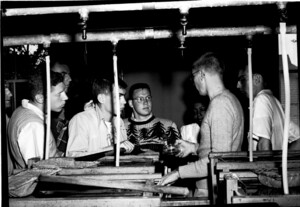It would have been surprising if Hamburger had not become a regular visitor to MBL, because of his work with Lillie at Chicago. In fact, much of the Chicago department migrated to the Woods Hole seashore to carry out research during the summers. In addition, Hamburger followed Lillie in teaching and then directing the Embryology Course from 1936 to 1945. At the same time Hamburger’s Chair of the Zoology Department at Washington University, Caswell Grave, a distinguished invertebrate zoologist, had been Director of the MBL Invertebrate Course from 1912-1917, an investigator every summer at Woods Hole and a Trustee of the Laboratory from 1920-1940. So, involvement at MBL was inevitable! As with his predecessors, Hamburger's approach to the Embryology course took advantage of the marine organisms available at MBL by having students collect their own specimens and study the comparative development of sea urchins, squid, protochordates and vertebrates such as fish [‘See Fig 7 from NAS Biographical Memoir] He added to these traditional approaches the importance of learning the techniques of experimental embryology and the theory of embryonic induction. Hamburger’s lectures on induction, gastrulation, and the work of Spemann and his followers provided an insider’s introduction to some of the most important experimental embryology of the day. As students reported in the MBL’s newsletter, The Collecting Net, “a new wind blew through the old Embryology building” with the exciting work in experimental embryology being introduced into the course [Link to Collecting Net (1940 or 1941; original reference was from Hamburger’s “Notes”, p. 25]].
In addition to teaching in the embryology course, Hamburger’s time at Woods Hole was particularly rewarding because of the various colleagues he could work and spend time with over the course of several months. At a time when individual researchers were more isolated at their home institutions. the MBL provided a major forum for communication and collaboration among biologists. It was just this sort of interaction that led Hamburger and two other colleagues, Benjamin H. Willier (1890-1972) from Johns Hopkins University and Paul A.Weiss (1898-1989) from the University of Chicago to collaborate on a major volume, The Analysis of Development, which summarized the most recent thinking about development. Published by W.B. Saunders in 1955, the edited volume contained articles by specialists on particular aspects of development such as gametogenesis, early cleavage, nuclear-cytoplasmic interactions, as well as discussion of development in specific species. Particularly interesting was Hamburger’s collaboration with his old friend from the Spemann lab, Johannes Holtfreter (1901-1992) on the chapter about amphibians. Analysis of Development became the most influential compendium of classical, experimental embryology in the mid-twentieth century.
Remarking on his time in Woods Hole, Hamburger recalled: “Many but not all of the 10 summers I taught at Woods Hole, from 1936 to 1945, I spent with the family. Several summers we rented the same small house on Park Street, called “Acorn” because it was owned by Mr. Oak, an amiable native. It was about a 10-minute walk to the laboratory and half a block from the Lillie houses. In 1940, the Walds [George Wald] from Harvard were our neighbors. Their boys were the same age as our girls, and they became playmates. George was at that time disturbed and nervous; he felt insecure because the decision of his tenure at Harvard was pending. Tenure, as well as fame and a Nobel Prize were in store for him.” Hamburger’s overall evaluation of his time in Woods Hole mirrored that of many biologists both before and after him: “Due largely to the congenial and relaxed atmosphere in Woods Hole, this was one of the most enjoyable and rewarding teaching experiences in my life.” [Hamburger, “Notes”, p. 26; Allen “Pact with the Embryo”, JHB 37 (2004): p, 448
- Allen, Garland E. "A Pact with the Embryo: Viktor Hamburger, Holistic and Mechanistic Philosophy in the Development of Neuroembryology, 1927–1955." Journal of the History of Biology 37 (2004): 421–75.
- Cowan, W. Maxwell "Viktor Hamburger and Rita Levi-Montalcini: The Path to the Discovery of Nerve Growth Factor." Annual Review of Neuroscience 24 (2001): 551–600.
- Hamburger, Viktor. "The Journey of a Neuroembryologist." Annual Review of Neuroscience 12 (1989): 1–12.
- MBL History Project. (2016). Victor Hamburger Papers. https://hpsrepository.asu.edu/handle/10776/9/discover
- Maienschein, Jane. (2011). Maienschein: 100 Years Exploring Life. Charleston: Nabu Press.

